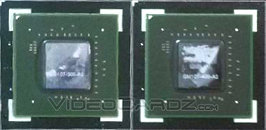Thursday, February 6th 2014

NVIDIA GM107 "Maxwell" Silicon Pictured
Here is the first picture of a couple of NVIDIA GM107 silicons in a tray, ahead of graphics card assembly. The packages appear to be as big as those of the GK106 from the previous generation, however, the die itself is estimated to be smaller, at roughly 156 mm², compared to the 221 mm² die of the GK106, and the 118 mm² of the GK107. The best part? All three chips are built on the same 28 nm silicon fab process. So what makes the GM107 die smaller than that of the GK106 despite having a similar feature-set? Narrower memory bus. The GM107 is said to feature a 128-bit wide GDDR5 memory interface, in comparison to the 192-bit wide interface of the GK106.
Apart from the 128-bit wide GDDR5 memory interface, the GM107 is said to feature a total of 960 CUDA cores, 80 TMUs, and 16 ROPs. The CUDA core count is identical to that of the GK106. The GM107 is built on NVIDIA's next-generation "Maxwell" GPU architecture. It will form the foundation of two SKUs, the GeForce GTX 750 Ti, and the GeForce GTX 750. The former features the full complement of 960 CUDA cores; while the latter is slightly cut down, and features just 768. The TDP of the GTX 750 Ti is approximated to be around 75 Watt. If true, the GTX 750 duo will set new standards on the performance-per-Watt metrics. NVIDIA is expected to launch both, later this month.
Source:
VideoCardz
Apart from the 128-bit wide GDDR5 memory interface, the GM107 is said to feature a total of 960 CUDA cores, 80 TMUs, and 16 ROPs. The CUDA core count is identical to that of the GK106. The GM107 is built on NVIDIA's next-generation "Maxwell" GPU architecture. It will form the foundation of two SKUs, the GeForce GTX 750 Ti, and the GeForce GTX 750. The former features the full complement of 960 CUDA cores; while the latter is slightly cut down, and features just 768. The TDP of the GTX 750 Ti is approximated to be around 75 Watt. If true, the GTX 750 duo will set new standards on the performance-per-Watt metrics. NVIDIA is expected to launch both, later this month.

29 Comments on NVIDIA GM107 "Maxwell" Silicon Pictured
Looking at 700 series, GTX 760 is at 170W with "only" 192 more cores, 256bit data bus and 980MHz gpu speed.
The problem with the two cards idea is that Nvidia cut out the SLi support in the cheaper cards. Don't expect SLi support with these cards.Didn't read correctly the part about "same PCB". I don't expect something like that anyway.
The fact that a card like this might cost about $250, maybe it wouldn't make it financially viable. Also it doesn't offer much as a publicity stunt. ASUS's card was fast enough to be advertised as "faster than Titan" this might be faster than 760 and with less power consumption, but not something that someone would be interested in buying. A single gpu is always preferable.
So slighty smaller than the Bonaire XTX, with it's 115W TDP, and by the Fire Strike above much like a reference R7 260X.
Look at that valley score, this will compete with 7790 and maybe 260x at best.
From the Videocardz link bta linked to, it clearly shows that the fully enabled (960 shader) die is ~75W. You also posted on the previous articlewhere the original SweClockers linkbta provided clearly stated:Yet you still persist is attributing your own arbitrary numbersAll this, when every source seems to note that the cards leaked are overclocked SKUs, and still don't utilise anything other than the PCI-E slot for power.
:banghead:
I'm just reading the information as provided from both the TPU articles, and there’s always someone here to provide a alternate opinion. I'm not the only one on this thread that's skeptical of a Ti OC not needing the 6-Pin.
First, that “other” TPU article never mentions the TDP for either. I don't read Swedish and won't normally have time to translate every article, it's a shame that information was omitted within btarunrs’ re-write, take that up with him. If you look I wrote that several hour before the post here.
While yes I just miss-read it denoting the "Ti" designation; "The TDP of the GTX 750 Ti is approximated to be around 75 Watt". With all the designators Ti /non-Ti and former/latter bantered-about I just took away the wrong information, a simple mistake. While are you saying even the OC'd (and are you indicating Ti's) don't utilize anything other than the PCI-E slot power?
I'll hold to a wait and see as we know much of this communication get convoluted and mixed-up just as I have.
I can't translate that but its clear 6pin is there and its referring to the 768 core variant.
Good find Xzibit :toast:
But we can't trust that either as is says a 768 cuda with a 6-pin while marked as a GTX 750. Who's right?
GK107 was a 75w(-)
GM107 reference or not 750/750 Ti is looking like a GK106 75w(+). It also might be there able to stretch out a bit more on a smaller die to sell smaller dies at a higher margin.
Nvidia could just paper launch a reference card that doesn't need a 6pin and let the partners add a 6pin. Nvidia can say it doesn't need one but the partners added.
If wrong and they're better... all the better, but given the information we have to scrutinize it seems to be shaping up as such. Holding to 28Nm is probably one of the biggest limiting issues to the efficiency. Maxwell it's self is evolutionary; it's 20Nm/Denver/UVM that will make it revolutionary.
The only Kepler cards that didn't require a 6-pin connector where all 384 cores or less and didn't have boost clocks.